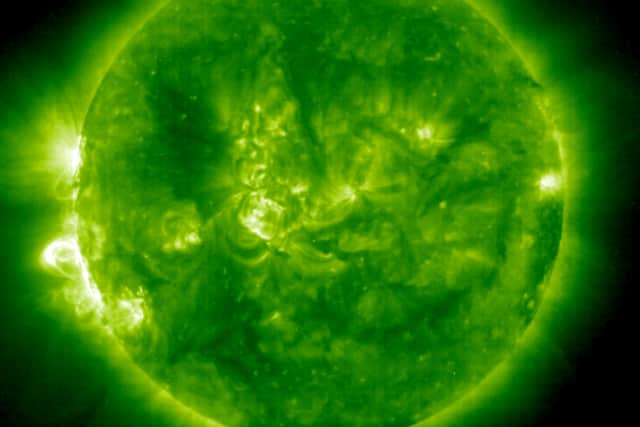When is the next solar storm? Date flare from sun will reach earth 2022 - and what disruption will it cause
and live on Freeview channel 276
A solar storm could hit the earth today (3 August) after a hole has opened up in the sun causing high-speed solar winds.
According to the National Oceanic and Atmospheric Administration’s Space Weather Prediction Center (SWPC), the storm has the potential to cause power grid failures, disrupt satellites and the migrations of animals.
Advertisement
Hide AdAdvertisement
Hide AdSolar storms are caused when the sun releases charged particles that interact with the earth’s atmosphere causing a reaction.
If strong enough they can disrupt satellites, shut down power grids and interrupt GPS and other communications networks.
According to SpaceWeather.com “There’s a loop of plasma on the sun’s eastern limb so large that normal scientific notation doesn’t describe it.”
The website described the solar activity as “ginormous.”
Here’s everything you need to know about when the next solar storm will hit and what this means for earth.


When is the next solar storm?
Advertisement
Hide AdAdvertisement
Hide AdThe next solar storm is predicted to “likely” impact the earth’s atmosphere on 3 August.
The solar storm is believed to have been triggered after a coronal hole opened up in the sun.
Coronal holes are cooler and less dense parts of the sun, they loop outward into space, allowing high-speed solar wind to escape, meaning it could be potentially directed towards earth.
SWPC have predicted the upcoming storm after discovering: “gaseous material is flowing from a southern hole in the sun’s atmosphere.”
Advertisement
Hide AdAdvertisement
Hide AdAccording to SWPC, the storm is classified as a Minor G1-class, which is the lowest ranking level.
A Minor G1-class will only offer a minor impact that can affect weak power grids, satellite operations and migratory birds.
They are the most common type, thought to hit Earth approximately 900 times over each 11-year solar cycle.
Solar activity rises and falls in cycles, with the activity of our sun slowly growing in intensity.
Advertisement
Hide AdAdvertisement
Hide AdScientists have predicted it will reach its solar maximum in 2025, but there are concerns about what impact this predicted space weather will have on earth.
What is a solar storm?
A solar storm occurs when the sun releases huge amounts of energy which form as solar flares and coronal mass ejections.
They send a stream of electromagnetic waves towards the earth at a speed of three million miles per hour.
When a solar storm hits the earth’s atmosphere it can produce dazzling displays like the Northern Lights, but it also has the ability to impact satellites, the power grid and GPS communications.


Are solar storms dangerous?
Advertisement
Hide AdAdvertisement
Hide AdSolar storms are not dangerous to people down on earth as we are protected by the earth’s atmosphere.
However, if electronics or communications are impacted, this could cause widespread disruption around the world.
Can solar storms affect electronics?
Solar storms can affect electronics and have been known to cause power outages in the past.
On 13 March, 1989, the entire region of Quebec in Canada was left with a power blackout after a solar storm took out the electricity grid.
Advertisement
Hide AdAdvertisement
Hide AdThe storm that hit was considered to be the strongest geomagnetic storm since 1930 and caused the biggest ever power outage to date.
The solar storm predicted to hit earth by the Nasa model isn’t going to hit ihas the potential to impact satellites that circulate around our planet and anyone using GPS signals.
Comment Guidelines
National World encourages reader discussion on our stories. User feedback, insights and back-and-forth exchanges add a rich layer of context to reporting. Please review our Community Guidelines before commenting.
